#my art is slowly deteriorating in quality as is with my sanity
Explore tagged Tumblr posts
Text
fuuta as this meme

and heres another silly fuuta. the blorbo

290 notes
·
View notes
Text
On Mark Fisher, Hauntology and Acid Communism
17 May, 1980 – On the night Ian Curtis killed himself, he watched Werner Herzog’s Stroszek on the BBC. Herzog’s existential tragicomedy is an askance vision of the American dream where the soul and sanity slowly erodes. Escaping physical torment in Berlin, alcoholic busker Bruno Stroszek migrates to rural Wisconsin with prostitute Eva and elderly neighbour Scheitz in hope of a better future, only to be broken further by illusionary promises of prosperity. Here, they kick you spiritually, Bruno says, and ‘do it ever so politely and with a smile, it’s much worse’. Eva leaves Bruno as bills amount and his mobile home is repossessed and auctioned off. Scheitz (whose mind has decayed) and Bruno attempt to rob a bank. They find it closed and instead stick up a barber shop. Scheitz is arrested and Bruno flees to a drab Cherokee amusement-park in a truck with his remaining possessions: a shotgun and a frozen turkey. The film’s conclusion reproaches any promise of a meaningful future existence as life deteriorates into absurd repetitions: the truck drives itself in circles until it catches fire, Bruno rides a chairlift up and down until he shoots himself – “Is this really me![?]” emblazoned on the back of the seat – and, most prominently, a chicken dances around and around and will not stop.
Watching these final moments now, it’s easy to see how Stroszek could have resonated with the Joy Division frontman and acted as what Herzog would call a ‘ritual step’ to his suicide hours later. The inane loop that Herzog presents feels like he was wiring directly into the interior world of the depressive, a place where any anticipation for the future is foreclosed by a sense of pervasive liminality. In my own experience, this mindless repetition is what depression is most like. Feelings of emptiness pervade much more so than any abject sadness. To be sad suggests the reverse is possible. Instead, life feels devoid of meaning, so there isn’t anything to feel in the first place. You simply go through the motions of life despite feeling that they are pointless and, often, ridiculous. Journeying the arctic wastes, getting closer to nowhere. Joy Division was jacked into this void. Driving bass lines and mutated disco rhythms spoke to the heart of nothing more than gentle instrumentation and whispery vocals ever could – you can dance, but what for?
But to be depressed is often more than just a chronic mood of despair felt within. The depressive enters an exchange with the world where their mental state is projected onto their surroundings, the same surroundings that seem conducive to that very depression. The repetitive motions of daily life are thus not just absurd to you but seem innately so. In a world that seems destined to collapse in a cocktail of geo-political crises, (cyber)wars and the obsoletion of meatspace it feels pointless to work towards a future that will decay into nothing. Existentialism is a pervasive mood for us younger generations and the increasingly endemic state of mental illness in Britain is not just a reflection of today but of the fact that tomorrow looks no different.
Mark Fisher believed that this psychological loss of the future is the pathological condition of 21st century subjectivity. In Ghosts Of My Life, he argues that our sense of a linear progression of time has drained away – the futures that were promised yesterday have failed to transpire today. For Fisher, this ‘slow cancellation of the future’ (quoting Franco Berardi) is felt at a cultural level. The rapid forward momentum of 20th century cultural production has been displaced, we no longer experience the radical breaks and dislocations in culture that were felt in the previous century. Instead, a formal nostalgia dominates the present as contemporary mass culture expresses an overwhelming tolerance for the archaic. UK music provides his best examples as artists such as Adele and the Arctic Monkeys have naturalised ‘a vague but persistent feeling of the past’ through their reconfiguration of 20th century sonic qualities. Any progress is now minor and incremental, weighed down by declining expectations – the cutting edge has been dulled. The result of this cultural anachronism is the experience of time being lost, ‘it doesn’t feel as if the 21st century has started yet’. As Adam Curtis says at the beginning of his recent documentary series Can’t Get You Out of My Head, today’s paralysis is ‘giving you today another version of what you had yesterday and never a different tomorrow’.
This cultural impasse is the product of structural and political conditions. Fisher argues that neoliberal capitalism has deprived us of the resources for artistic experimentation, not only in economic terms but also at the level of consciousness. Increasing demands on time, money and attention means we are we are too tired for original cultural production and attentive consumption; comfort and profit is safe within the already proven familiar. The intense rhythm that life now runs at has reduced our capabilities to dream. Massive collective overstimulation means we are no longer able to journey into the depths of subconsciousness and reach out to what’s on the other side. Our lives in hypermediated cyberspace have replaced neural pathways with proxy minds that endlessly trigger us into states of simultaneous boredom and anxiety, beyond thought and concentration into rapid-fire data processing, what Fisher calls ‘post-literate schizo-subjectivity’.
As Frederic Jameson explains in his influential essay ‘Postmodernism and Consumer Society’, the schizophrenic experience (used descriptively, not clinically) is one of temporal discontinuity; time and meaning breaks down and the schizophrenic subject can do nothing and becomes no one. Jameson similarly claims this experience of schizophrenia is an expression of the logic of late multinational capitalism whereby consumer society folds into obsessive repetition, an intense, hallucinatory and unbearable experience of being ‘condemned to live a perpetual present’. Stroszek’s temporal loop seems particularly resonant here: the tireless demands of subjectivity create a pointless dance that repeats endlessly and the resulting depression that envelops Bruno is the same that plagues us now. The ‘crushing sense of finitude and exhaustion’ of the 21st century that Fisher describes means we are unable to create unimaginable futures.
If popular music culture was Fisher’s most applicable symptom when writing in 2013, then popular cinema is the abject example of cultural stasis today. Fisher cites Jameson’s other feature of consumer capitalism’s postmodernity, pastiche, as demonstrative of how culture disguises its archaic form via new technologies. But Jameson’s example of pastiche’s mass culture manifestations, the ‘nostalgia film’, needs to be updated. If Star Wars gratified a deep longing to revisit Buck Rogers serials hidden within its special effects, the continuation of Star Wars today gratifies a longing to return to itself, demonstrating a new level of formal nostalgia. The first of the franchise’s sequel trilogy, The Force Awakens, is shameless in its re-hashing of the (un)original A New Hope. Minute upgrades to iconography, lazy name changes that do little to guise the recycling of archetypes and the pageantry of original cast members and classic props illustrates how the “new” Star Wars is an overt re-run of its own past. Pastiche is now fucking itself.
The dominance of this hyper-pastiche, the prevalence of reboots, remakes and latter-day sequels, speaks to how the nostalgia film is no longer obfuscated as new but foregrounded as a revival of past forms. An overwhelming reliance on recovering recognisable titles and building franchises based on past media churns out zombie forms that market nostalgia as the norm, a sign that the slow cancellation of the future’s gradual waning of cultural progression has reached its final halted form. Cryostasis. Mass culture doesn’t need to pretend to be new anymore, technology now facilitates artificial immortality to endlessly force a reverence for the past and never move on. Nowhere is this more evident than in the resurrection of actors via CGI. Late capitalism’s relentless desire to sell us the same product on repeat has risen the dead. And it is the inherently soulless and uncanny nature of these undead non-performances which is so exemplary of how popular cinema and the rest of our lumpen mass culture feels so deflating.
Nothing has changed since Ghosts Of My Life’s release in 2014, at least not for the better. But whilst Fisher was able to chart the slowdown of time by contrasting the lassitude of today with the futures projected by the ‘recombinatorial delirium’ of Jungle, Trip Hop and the rest of the experimental music culture he experienced in the 90’s, I’m part of a generation that has only ever known the malaise of the 21st century. The depression that Fisher describes is caused by the failure of the future, life getting worse, whereas young people today have no sense of difference, we’ve never had a future. The full realisation of Jameson’s postmodernism, where there are no new styles and worlds to invent, means art can no longer offer visions beyond today’s faltering economy, unstable job market and dismal political landscape, not to mention the apocalyptic weight of climate change that the youth of today will be the first to truly contend with. Having never known culture’s true escapist capabilities and only ever a postmodern fragmentation, this generation exists without hope or meaning, even for something that has been lost. The return of the void (Fisher writes: ‘If Joy Division matter now more than ever, it’s because they capture the depressed sprit of our times’). It’s no wonder that British youth live only for occasional weekends and short-lived summers. A half-life of binge drinking in parks, shit club nights and raves-that-aren’t-what-they-used-to-be in hazes of lager, cannabis and amphetamine/ketamine/benzodiazepine infusions that stimulate some remnant of feeling (“I love you mate, but I don’t know who you are”) only to come crashing down into unbearable mornings-after, heart palpitations and devastated mental health. We don’t want to grow up, because there’s no world to grow up into.
This isn’t to say that contemporary culture is completely devoid of anything worthwhile. There are glimpses of the new and the other, but these arrive disparately. The internet has completely restructured consumption. Paradoxically, the interconnected digital world has made culture feel disconnected from the individual in that it now seems to only exist in the realm of cyberspace, separated from real life and away from something tangible. The spaces of subculture have been reduced to forums and comment sections, drawing in members from around the world but retreating its presence from the milieu of everyday life. Without this tactility, there isn’t a sense of a cultural project, that you’re a part of something bigger. Punk’s outward anger rears its head now and again, yet in the age of personal instability, this energy is often inverted inwards into the mental turmoil and isolation of Post-Punk (see Black Country, New Road). Fisher’s argument is that what is lost in the 21st century is a trajectory, the creative force to create new worlds. The classic YouTube comment-turned-meme, “I was born in the wrong generation”, now seems more than just an adage for 13-year-olds discovering Led Zeppelin or Nirvana. It’s a yearning for a time when cultural production coalesced into a shared energy with which to sculpt the future.
It’s this emotion of yearning that constitutes Fisher’s reaction against these lost futures, his adaption of Derrida’s concept of hauntology. Hauntology is explained through Freud’s notion of melancholia: a refusal ‘to give up the ghost’ – Fisher’s refusal to adjust to the current conditions. Freud writes that ‘melancholia behaves like an open wound’ and, for Fisher, this wound is his longing for the ‘resumption of the processes’ of the cultural and political momentum of the 20th century. It’s not that the culture of the past was necessarily better than the anachronistic reconfigurations of today, but that the aforementioned energies of cultural production promised more. The libido remains attached to this original, uninterrupted timeline. Hauntology is the virtual spectres of what should have been, a stain on the temporal loop that reminds us that time was supposed to move forwards.
It admittedly took me a while to “get” hauntology, probably because I’ve never known anything but the depression of the 21st century. The pages that make up most of Ghosts Of My Life are essays about certain hauntological traces and phantom presences that still linger. At first glance, these chapters seem to be little more than disparate fragments of Fisher’s own haunted house, nostalgic vestiges of things he used to love. I wasn’t sure if these ghosts were able to rupture the fabric of futurist defeat. The use of hauntology to describe the sonic textures of artists like Burial and The Caretaker complicated things further in my mind. Hauntology seemed instable, although this is part of its appeal and its very nature. I soon started to understand that the identification of hauntology was an act of resistance, but it wasn’t until I read Fisher’s introduction to Acid Communism that the yearnings started to make sense as alternative possibilities.
Acid Communism calls for the resumption of the momentum of 60’s and 70’s counterculture. The spectre of this period – ‘a time when people really lived, when things really happened’ – offers a return to the open modes of consciousness that defined countercultural thought and promised unbridled freedoms, freedoms which Fisher again argues have been thwarted by the project of neoliberalism. Fisher writes that the 60’s still haunts us today because the futures projected by the counterculture have failed to happen – another future lost. The exploration and experimentation of new modes of consciousness in this period turned the metaphysical into the mainstream and ‘promised nothing less than a democratisation of neurology itself’. To re-ignite the psychedelic, spiritual and social imagination of the counterculture today would allow us to interrogate the very conditions that subjugate us to the temporal loop and reduce us into somnolent agents of mindless cyberspace. Going back to the notion of depression as a suspicion of modern life’s inherent absurdity, adopting new modes of thought and perception can make us lucid to just how ridiculous our lives today really are. Fisher’s commentary on Jonathan Miller’s Alice’s Adventures in Wonderland is particularly evocative: ‘In the solemn and autistic testiness of the adults who torment and perplex Alice, we see the madness of ideology itself: a dreamwork that has forgotten it is a dream, and which seeks to make us forget too’. What Acid Communism proposes is what hauntology yearns for. To reconnect the trajectories of the past to where they should be now, to carry on where the counterculture left off, to continue the mass exploration into new ways of seeing and thinking, to find the energy needed to break out of the cultural impasse and to invent the futures that are unimaginable now but were once seemingly inevitable.
However, just like the counterculture, Acid Communism is an unfinished project. Fisher committed suicide in early 2017, leaving behind just a draft of the introduction. Acid Communism has become hauntological in itself, leaving us to wonder what new futures could have been imagined if the book was completed and if Fisher lived on and continued to confront our absurd postmodern (un)reality. The phantom that remains, the phenomenal body of work that he left behind, collected in books, articles, lectures and in the databanks of k-punk, haunts us because Fisher’s philosophical resistance, (cyber)punk attitude and unrelenting intellectual creativity continues to be needed and the ideas are only becoming more pertinent.
Further into the depths of cultural inertia, hauntology is now more important than ever. To keep the wound open resists accepting the continuation of the depressing conditions of the 21st century. But having only ever known time in stasis, it’s hard to be melancholic for a cultural trajectory that I’ve never been a part of. Perhaps the only hauntological trace that can truly resonate for me is Fisher himself. It’s no coincidence that this first blog post is about him. Fisher writes that beginning his k-punk blog was a way of working through his depression and my reasons for writing are similar and directly inspired by his work (the title of this blog comes from a phrase Fisher used to describe the bleakness of depression). Moving through my early twenties has frequently felt unbearable as I’ve become more conscious to how meaningless life is, or rather, how meaningless life now feels. Looking to the future is often an unsettling process in that it’s difficult to imagine anything positive. This sense of precariousness isn’t unique to this time. Yet, I wonder if growing up in the 21st century isn’t wrought with uncertainty but, rather, with a certainty that things will always be empty. Fisher introduced me to alternative possibilities from this painful existentialism. His work is all about uncovering traces of the Outside, finding the future in the strangest of places. Through Fisher I started thinking beyond again, reconnecting with the weird dreamworlds of my childhood.
The loss of Fisher leaves us with an imperative to continue the project, to continue tracing hauntological spectres, cultural fragments and new (or forgotten) ways of thinking into awakening the future. If we can’t immediately conjure up the counterculture, then we can continue the trajectory of the more immediate ghost that is Fisher’s spirit of resistance. This feels as difficult as it is crucially important. For my generation, depression is inborn, life feels immobile, defeat is hardwired. However, whilst Ian Curtis found confirmation of life’s futility in Stroszek, David Lynch was watching the very same transmission and reportedly was filled with joy and inspiration which motivated him through the difficulties of filming The Elephant Man. This story speaks to Fisher’s optimism at the end of Capitalist Realism: ‘The long, dark night of the end of history has to be grasped as an enormous opportunity[…] From a situation in which nothing can happen, suddenly anything is possible again.’ Life has become malleable, and the void should be seen as a blank canvas. The challenge is to dream again. To find a way to detach ourselves from the numbness and insomnia of cyberspace and the dopamine-laced seduction of the pleasure principle. Exploring the depths of consciousness is not just an experiment of isolated self-discovery, it’s a mode to rediscover a universal humanity. Disconnection becomes connection. Somewhere in the mind lies a communal future and, at a time when there seems to be no such thing, the answer may be unexpected, strange and just what we need.
Thanks Mark, I miss you.
63 notes
·
View notes
Text
BECAUSE I’M NOT POPULAR, I’LL READ WATAMOTE: CHAPTER #141
The first half of Golden Week is over, and Tomoko has found herself the object of “platonic" affection for four different suitors. And as our intrepid heroine muses over the which of them to pursue, out of nowhere comes the dark horse. Once thought to be missing in action, this little girl, having been there since the very beginning, threatens to overtake the competition in one psychotic swoop.
Chapter 141: Because I’m Not Popular, I’ll Go to School with Kii-chan
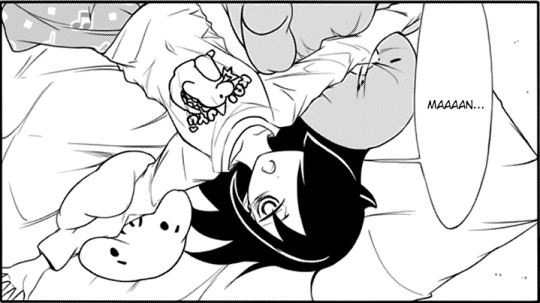
The things that Stuffed Yuu-chan and Pals have seen...
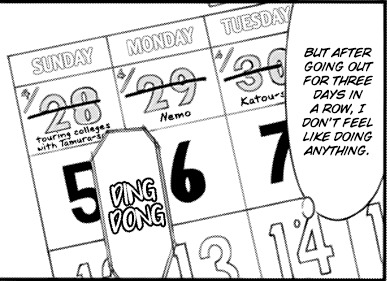
Ah, the classic Introvert Burnout. I had a feeling Tomoko would be drained after having what may have been the most socially stressful time of her life. Not simply for being social, but for how much she had to navigate as a fish out of water. Each “date” involved a new experience for Tomoko to address, and that much effort at once can be really exhausting for a layabout like her.

That my friend is what we in the TvTropes community call, “Tempting Fate”.

Heeeeeere’s Kii-chan!
Can’t even begin to tell you how much I love this entrance. We all know who Kii-chan is. But even those outside of the loop would get a feel for who she is. Adorable and sweet-natured, but disturbing due to an apparent lack of negative emotions (even when appropriate). Ah, Kii-chan, it’s been far too long.

Nothing to say here, really. Just think it’s a particularly lovely picture of Tomoko.

Because the popularity of a manga series is largely dependent on real-time reception, it’s very common for mangakas to add new, “popular” characters, or give the spotlight to characters who’ve been out of focus. Watamote is no exception. It may seem contrived to bring Kii-chan back after being gone for a while, but it works here because it relies on Kii-chan’s character to it, instead of a series of implausible plot developments. Kii-chan is just considerate of her cousin’s schedule–that’s all we need.
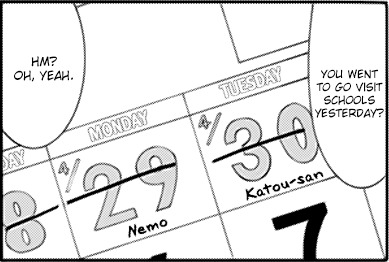
The first hint of Tomoko’s reawakening as the role model onee-chan.

One of the perks of being a sporadically-appearing character is that you can really see just much the art style has evolved since the character’s last appearance. For Kii-chan, she hasn’t really changed much design-wise other than being a little taller. But even then, the linework is much cleaner and consistent this time around, which compliments the more “everyday slice-of-life” approach Watamote’s been embracing.
If only she could grow a nose.
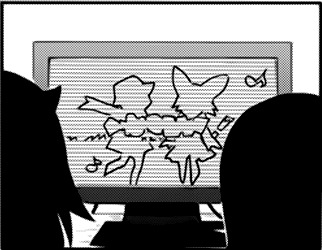
The best thing about this type of censorship is that you don’t necessarily have to understand what's being censored. All you really need is a bit of context to put the pieces together. The outlines are detailed enough that we can see the characters as some kind of humanoids with animal features. And given what we know about Kii-chan, it makes perfect sense.
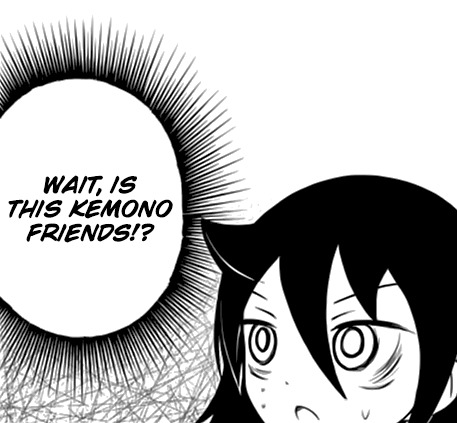
Y-Yeah, I...I’ve totally heard of that show.
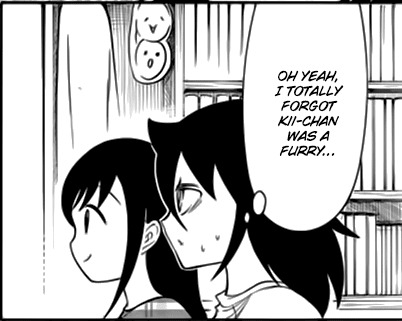
Other than the whole Ucchi situation (which is slowly becoming an unintentional blessing), this is the last of the misunderstandings that still needs resolving. It’ll be hard, though, since this particular issue isn’t that troublesome. For now...

Look at that platonic sibling bonding.
Perhaps I’ve been conditioned by manga/anime, but I find it refreshing how Watamote has managed to develop the Kuroki siblings’ relationship while avoiding any incestual subtext. Lots of series oversell the sibling relationship by having them be overly affectionate and clingy. With Watamote, their bond feels organic because they don’t have to be touchy-feely. An unspoken quality time is all there is to it.
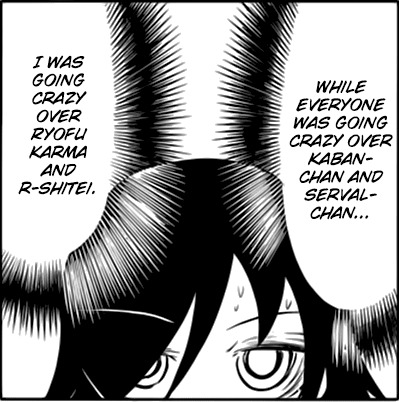
It’s hard to get a read on Tomoko’s emotions here, but at the very least, she seems troubled. It could very well be that Tomoko just realized that she’s changing in regards to the media she consumes. The former her would’ve probably jumped on the Kemono Friends bandwagon, but the reality is, Tomoko’s otaku interests are being compromised by the mainstream, at least as mainstream as rap battles get.
But the kicker is...she realizes this change isn’t all that bad.

Of course, nothing beats watching anime with your psychotic cousin.
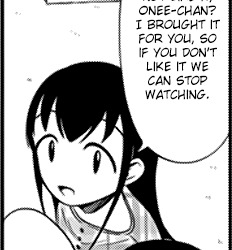
The whole “pet-sitting” relationship they have here is a tricky one since each side is trying to accommodate the other based on “flaws” that don’t exist (or no longer exist). This usually results in an endless cycle of misunderstandings that lead to nowhere, but this confusion has transcended that cycle to develop into a progression of sorts. Similar to the Ucchi situation, the absurdity became so frequent that it just became reality. One that each side has been influenced greatly from.
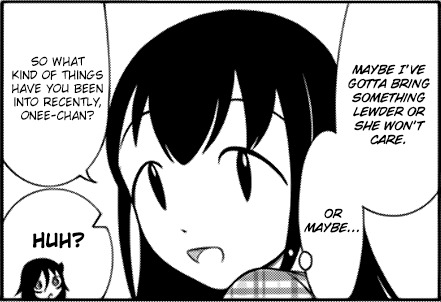
With her constantly adorable face, you forget that Kii-chan is a middle-schooler and is therefore old enough to know about things like sex and perversion. Like Yuu-chan, she may look innocent, and while she was aware of such things as a kid, she didn’t really get it until they approached high-school age.

You know, I read this really good manga called Kaguya-sama: Love is War (shameless plug, I know), and they actually had a chapter about a rap battle a while back. Given that both series tend to be up-to-date on contemporary trends, it makes me wonder...has rap suddenly become a hot thing in Japan? Or has it always had its niche audience?
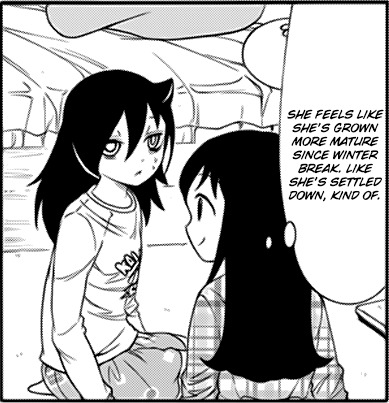
I’m sure many fans knew that this was going to be an inevitable development whenever Kii-chan showed up again. Unlike Tomoko’s school friends, Kii-chan wasn’t there to see the slow, gradual growth of Tomoko’s character, so it must have hit her like a ton of bricks to see her precious onee-chan go from helpless loner to mature teen in the blink of an eye.
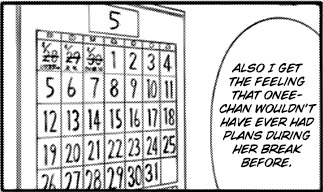
Sometimes I wonder just how pitiful Kii-chan thought Tomoko really was...
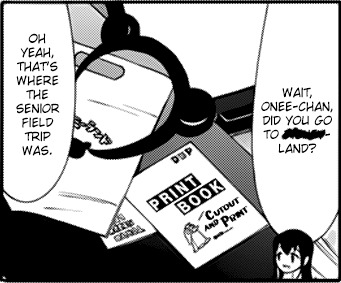
Why would you censor Disneyland now of all times?

Those of us who were clamoring to get close-ups of the photos taken in the Disneyland arc finally get their wish.
The Kowarith photo is my favorite, even though two-thirds of the people in it are faking their asses off. While that may be my personal bias towards the Tomoko-Yoshida-Yuri trio, I think it reflects a better sense of kinship between the girls. The effort is there, phony as it is, to support each other in an awkward situation, which is fundamentally what the series is all about.
The assumedly Fireworks photo is also pleasing, make no mistake. You can definitely feel more genuine emotions (or lack thereof) being expressed than in the other photo. But this focuses more on the individual than how they work as a collective group, despite there being more people. The girls ultimately look like six different colored Skittles–part of the same package, but each unique.

Could this be the start of Kii-chan revitalizing her perception of Tomoko as a super popular girl? I sure hope so.

How ironic. Kii-chan’s perspective of Tomoko is starting to grow ever so gradually on the upside, whereas Tomoko’s perspective of Kii-chan grows more and more negative.
Hang on, is that supposed to be some fake Dragonite shirt? Neat.

At this point, people assuming that Yoshida as some kind of punk based on her looks is a dead horse of an issue. Some stereotypes exist for a reason, I suppose.

I see your game, Nico Tanigawa, using a deliberately vague line about “two girls” to make your readers overanalyze a single panel. All I have to say to that is that I am completely and utterly guilty.
One of the girls is probably Yuri, if only because she’s the only girl to appear in both photos. As for the second girl, your guess is as good as mine. I’m inclined to say Ucchi because if Kii-chan only has their appearances to go on, then Ucchi and her emoji-face make quite the impression.
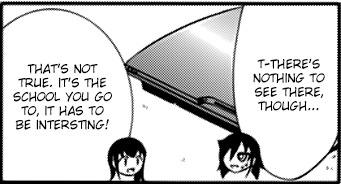
I’m getting Yuu-chan vibes here with the way Kii-chan phrases half-insults with a friendly demeanor.
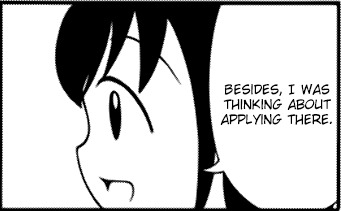
+ 1 TO THE HAREM.
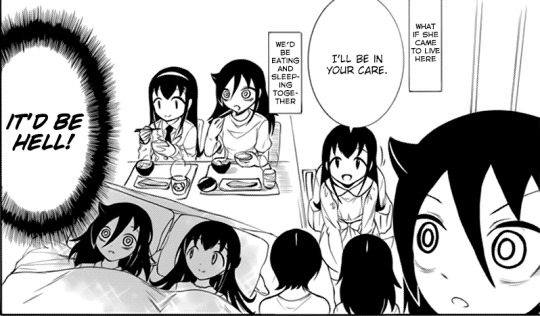
Kii-chan is definitely that relative you leave a self-imposed boundary on. Fine in small doses, like at parties and family gatherings, but long-term exposure is unhealthy for the brain. This isn’t even a wholly exaggerated fantasy on Tomoko’s part. Okay, the eating bit is a little much, but given that Kii-chan allegedly dreams about treating Tomoko like a pet, the latter is right to be a little concerned.

There needs to be an AU one-shot of Tomoko, Tomoki, and Kii all going to the same school at the same time. Right. Now.

I do appreciate that despite Kii-chan’s deteriorating sanity, Tomoko doesn’t view her as a lost cause and even tries to put a positive spin on it. Reconciliation Arc is a-go!
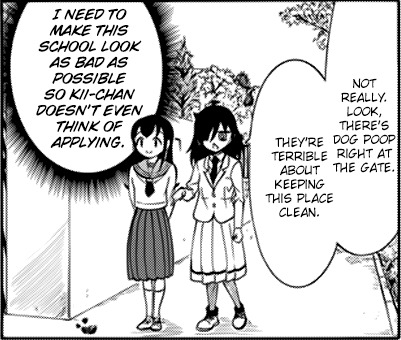
Did Kii-chan really have that big of a growth spurt, or has Tomoko just reached her peak in height? Not sure how far the genetics will go, but Kii-chan becoming taller than Tomoko is only going to make her even more intimidating.
This little scheme of hers is definitely reflective of the “old” Tomoko, but there’s a nice reversal going on here. Instead of Tomoko trying to make things sound cooler than they actually are, she’s trying to make things seem worse. Of course, Murphy’s Tomoko’s Law states that anything that can go wrong, will go wrong. Especially if Tomoko wants it to go right.

Ah, Ogino. The only character whose relationship with Tomoko has remained relatively unchanged despite indirectly having the most impact on Tomoko’s life.

Better update her Wiki page now.
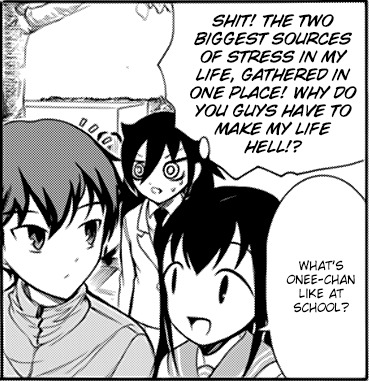
It’s pretty telling how it’s these two who cause Tomoko the most grief. It’s not the delinquent who routinely bashes her face in, not the pervert(s) lusting after her little brother, and not the otaku who passive-aggressively teases her. As for why, I think it boils down to the fact that Ogino and Kii-chan challenge her comfort zone the most. It also doesn’t help that Tomoko doesn’t interact with them as often as the others, so she hasn’t really had the time to get desensitized by them.

This freakin’ teacher, man.

The second worst part of Ogino’s “help” is that she never actually lies. Sure, she exaggerates to hell and back, but it’s always loosely based in reality, like some cheap movie adaptation of a best-selling novel.
But the worst part of it is...you can’t hate Ogino for it. Her personal assessment may be founded on largely suspect reasons, but it’s still an honest assessment. I have no doubts that Ogino really is proud of Tomoko, and that’s exactly why she’s the best worst teacher.
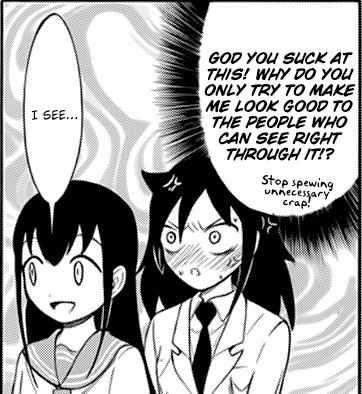
That’s true. If Ogino gave that spiel to people like Hijirisawa or Hatsushiba–y’know, people who don’t know her as well–they might actually buy that crap. But people who know Tomoko like Yuri or Nemo, people like us, can tell that Ogino’s sugarcoating the whole thing. Kii-chan, with her terrifying skill for knowing too much, is no exception.
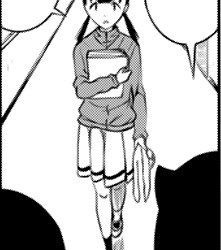
Ah, I see. This is one of those put-all-the-secondary-characters-who-we-haven’t-seen-in-a-while-into-one-chapter chapters.
Can’t complain, though. I like Itou.

“Or something” can also be translated as “lust after Tomoki”.
We don’t really have much to go on for how Itou views Tomoko, but I think it’s reasonable to think that she may not see her in that good of a light. Not only did Tomoko give off a weird impression when she played off the whole fist bump thing, but Itou’s “powers of perception” probably made her aware of Tomoko and Komiyama’s frenemy-ship, hence her “warning” that Komiyama was around.

The Inherent Awkwardness of Second-hand Relationships: The Life of Tomoko.
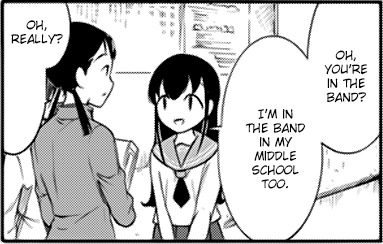
Betcha’ no one saw this interaction coming. Whether it’ll lead to anything more remains to be seen. Itou’s still got the whole “friendship potential” going on with Futaki, but given that she has the tolerance to BFF Komiyama, I see no reason why she can’t befriend a psycho like Kii-chan.

That desire to “loudly blow” is Kii-chan’s inner demons screeching out in desperation for release. I pity the fool who unleashes the beast.

That does sound like your typical amateur definition of a psychopath, doesn’t it?
For the record, I don’t actually believe Kii-chan is a psychopath, despite the jokes I made. There are way too many moments that discredit such a claim. Now, if you were to accuse Kii-chan as being some sort of deviant (sexual or otherwise) I might see that. But ultimately, I think Kii-chan was just a victim of having her innocence shattered too fast and too soon, which made her more, uh, crafty than Tomoko could handle.

Man, it’s been a long time while since we last saw Dicky-chan, hasn’t it? Hope we get to see more of her (and Sayaka, for that matter) after this chapter.
I love how even when she’s collecting masturbation material, Komiyama has to hold her camera phone all lady-like. If the term “purevert” ever needed a concrete definition, this girl would be it.
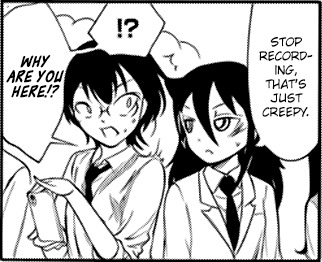
Main Character privileges, that’s why.

Get. The. FUCK. Out. Of. Here.
With each subsequent appearance, Komiyama’s standard for what constitutes a bitch primed to steal away her Tomoki-kun falls hilariously lower. It’s not enough that a girl in their class makes two seconds of eye contact with him, nosiree. Any girl with an inkling of a relationship with Tomoko is not immune, even if it’s his own damn cousin. Granted, I don’t think Komiyama would be so pathetically scummy as to confront Kii-chan about it like she did to Yoshida.
...I hope.

“Best friends” may be stretching it now that we’ve gotten this far in the series. However, there is one aspect of Tomoko and Komiyama’s relationship that triumphs over all the others:
Absolute candidness. Even now, the only one who gets to see the complete, raw package that is Tomoko Kuroki is Komi-something. While Tomoko has made substantial friendships with the likes of Yuri, Nemo, and Katou, Tomoko still restrains herself just a tad lest she pushes them away. It’s only with Komi that Tomoko bears her full ugliness, which I think has developed into some freakish level of respect/understanding that none of the others can claim.

Damn, even the bishounen dude gets to make an appearance. All we need know is Lethal Chef Girl to make a cameo and I’m set.

Nope. Any game is an away game when your “harem” shows up to cheer you on.
A few people have expressed discontent with how the chapter seems to end so abruptly, and it’s a fair criticism. It may be the lack of a “Next time...” tagline throwing people off, but while this chapter indeed ends at an odd point, it’s not that unprecedented. Some of the previous chapters ended this way, like that time Komi was all “Oi!” at Yoshida at the cafeteria, which indicates that this chapter is likely one of those series-of-vignettes that also doubles as a build-up chapter.
On a positive note, while the chapter does feel prematurely ended, how the next chapter plays out if it is connected to this one is sure to be a surprise.
#watamote#watamote review#chapter 141#no matter how i look at it it's you guys' fault i'm not popular!#tomoko kuroki#kiko satozaki#ogino#itou#kotomi komiyama#akari iguchi#tomoki kuroki#that one bishounen dude#review
29 notes
·
View notes